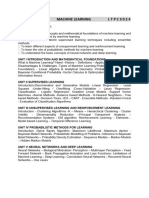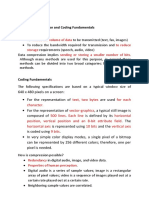Machine Learning
What is What is Machine Learning?
In the real world, we are surrounded by humans who can learn
everything from their experiences with their learning
capability, and we have computers or machines which work on
our instructions.
But can a machine also learn from experiences or past data
like a human does? So here comes the role of Machine
Learning.
“Machine learning enables a machine to automatically learn
from data, improve performance from experiences, and predict
things without being explicitly programmed .”
What is What is Machine Learning?
How does Machine Learning work
A Machine Learning system learns from historical data, builds the
prediction models, and whenever it receives new data, predicts the
output for it. The accuracy of predicted output depends upon the
amount of data, as the huge amount of data helps to build a better
model which predicts the output more accurately.
Suppose we have a complex problem, where we need to perform some
predictions, so instead of writing a code for it, we just need to feed the
data to generic algorithms, and with the help of these algorithms,
machine builds the logic as per the data and predict the output.
Machine learning has changed our way of thinking about the problem.
The below block diagram explains the working of Machine Learning
algorithm:
How does Machine Learning work
Features of Machine Learning
• Machine learning uses data to detect various patterns in a given
dataset.
• It can learn from past data and improve automatically.
• It is a data-driven technology.
• Machine learning is much similar to data mining as it also deals
with the huge amount of the data.
Need for Machine Learning
The need for machine learning is increasing day by day. The reason behind
the need for machine learning is that it is capable of doing tasks that are
too complex for a person to implement directly. As a human, we have
some limitations as we cannot access the huge amount of data manually,
so for this, we need some computer systems and here comes the machine
learning to make things easy for us.
We can train machine learning algorithms by providing them the huge
amount of data and let them explore the data, construct the models, and
predict the required output automatically. The performance of the machine
learning algorithm depends on the amount of data, and it can be
determined by the cost function. With the help of machine learning, we
can save both time and money.
Need for Machine Learning
The importance of machine learning can be easily understood by its uses
cases, Currently, machine learning is used in self-driving cars, cyber
fraud detection, face recognition, and friend suggestion by Facebook,
etc. Various top companies such as Netflix and Amazon have build
machine learning models that are using a vast amount of data to analyze
the user interest and recommend product accordingly.
Following are some key points which show the importance of Machine
Learning:
• Rapid increment in the production of data
• Solving complex problems, which are difficult for a human
• Decision making in various sector including finance
• Finding hidden patterns and extracting useful information from data.
Classification of Machine Learning
Machine learning can be classified into three types:
1.Supervised learning
2.Unsupervised learning
3.Reinforcement learning
History of Machine Learning
Before some years (about 40-50 years), machine learning was
science fiction, but today it is the part of our daily life.
Machine learning is making our day to day life easy from self-
driving cars to Amazon virtual assistant "Alexa".
However, the idea behind machine learning is so old and has a
long history. Below some milestones are given which have
occurred in the history of machine learning:
History of Machine Learning
History of Machine Learning
The early history of Machine Learning (Pre-1940):
• 1834: In 1834, Charles Babbage, the father of the computer,
conceived a device that could be programmed with punch cards.
However, the machine was never built, but all modern computers
rely on its logical structure.
• 1936: In 1936, Alan Turing gave a theory that how a machine can
determine and execute a set of instructions.
The era of stored program computers:
• 1940: In 1940, the first manually operated computer, "ENIAC"
was invented, which was the first electronic general-purpose
computer. After that stored program computer such as EDSAC in
1949 and EDVAC in 1951 were invented.
• 1943: In 1943, a human neural network was modeled with an
electrical circuit. In 1950, the scientists started applying their idea
to work and analyzed how human neurons might work.
Thank You























































































